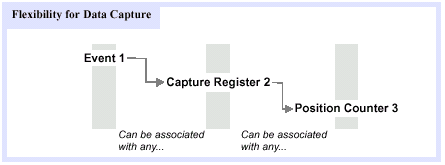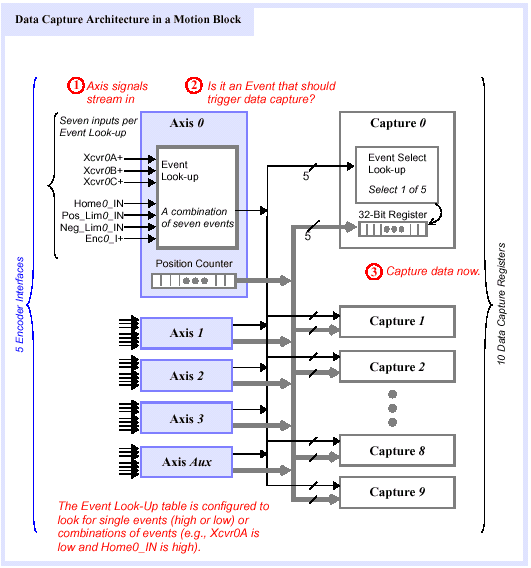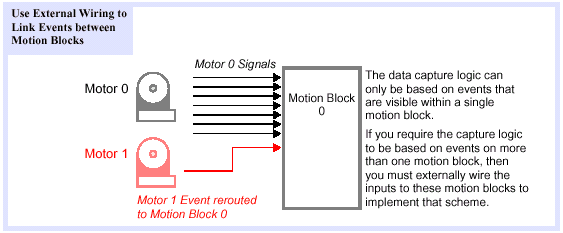| CHAPTER
6 XMP Controller Motion Drive I/O |
|||
Encoder InputsEach motion block provides up to five encoder interfaces (4 axes plus 1 auxiliary), with the following features:
Having five (5) encoders allows an encoder to each axis, plus a fifth encoder for master-slave, master-cam or dual-loop operations. Each motion block has features for position capture and position compare. Digital noise filtering is enabled by default and limits the maximum count rate to 10 MHz (2.5 MHz quadrature cycle). Position CaptureEach motion block maintains a set of ten 32-bit data capture registers (in hardware), used to store latched positions. The ten data capture registers are shared among the five encoder interfaces of each motion block. A specific capture register can be associated with any encoder (position) counter. Each capture register can be triggered by one of the five events (one from each of the five encoder interfaces). One event can trigger any number of captures, allowing probe capture of multiple axes. Events/Data Capture Registers/Position Counters
The free-running, 32-bit position counter for any axis can be latched on the edge of an input. The latency for position capture is sub-microsecond, because the registers are implemented in hardware. The input source and polarity are configurable. The capture event can trigger on any of:
Additionally, the capture event trigger can be enabled or disabled with software. Capture logic may be triggered from any one of the five Event look-up tables in a given motion block FPGA (one Event look-up table per axis, plus one spare table). Each Event look-up table has seven inputs. These signals are the three Xcvr signals for that axis plus Home, Pos_LIM, Neg_LIM and Index. The Event look-up table can be configured to use either polarity of any one input or combinations of inputs (for example, capture data if Home is low and Index is high). Event processing for data capture.
Although the Capture 0 register is normally used to capture the encoder (position) count for Axis 0, you can also use Capture 0 to capture the encoder counts for the other axes in that motion block (Axis 1,2,3), individually or as a group. Note that Capture events cannot cross between motion blocks, although you can work around this by externally wiring the axis inputs among multiple motion blocks. Position CompareEach motion block has a hardware register file of sixteen 32-bit registers which are used to provide compare setpoints. The sixteen registers are shared among the four axes. Buffer modes can be set up as FIFO or circular, so that compare events can occur faster than the servo update rate. Compare latency is less than 1µsec.
The compare event can set a Position_Compare output on any of the twelve available RS-422 transceiver outputs. The compare event status is also available to the DSP. The trigger event is software-configurable and will occur when the value loaded in the position compare register is either: In addition, the equality condition can be either transparent or latched. Note that the latched condition can be cleared. The Position_Compare output polarity is programmable and the compare output can be disabled. The register can also be read back by the host. Scale Interpolation Modules (SIM4)For encoders with sinusoidal outputs, the scale interpolation module provides increased position resolution for up to four axes. These outputs produce one cycle of sine and cosine analog signals for each encoder's line pair. At every sample, the scale interpolation module reads the sine and cosine levels and determines the angular position within the line pair. The sine and cosine outputs are also routed to the standard quadrature inputs, providing coarse position information.
The quadrature inputs generate 4 counts for every line pair, and the 12-bit interpolated value generates 4096 counts for each line pair. The full interpolated position is obtained by combining the number of quadrant counts divided by 4, with the position between two encoder lines. Essentially, the 12-bit scale interpolation provides a resolution increase of 1024 over the quadrature counters. To maintain accurate phase information, the sine and cosine signals are captured with simultaneous-sampling A/D converters. Position CompareTo implement the position compare feature, the SIM4 compares the current position to a position latched in the FPGA. The A/D converters convert continuously, with a 10µsec latency. Position Capture To
implement the position capture feature, the SIM4 latches the
full interpolated position when the user-supplied latch signal
is pulsed.
For detailed information about SIM4 modules, please see Application Note 206. |
|||
